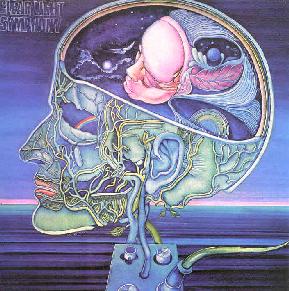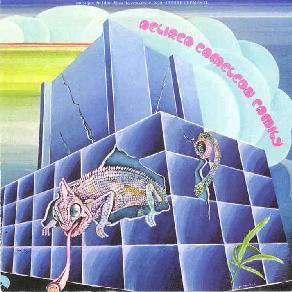 Clearlight - "Clearlight Symphony" (Clearlight 888 Music 1999/1973, C8M-001)
Clearlight - "Clearlight Symphony" (Clearlight 888 Music 1999/1973, C8M-001)
From Aural Innovations #12 (September 2000)
Clearlight was the brainchild of French pianist and keyboard wizard Cyrille Verdeaux. In 1963, at the tender age of 14, he was admitted to the prestigious French National Conservatory of Music in Paris and from 1966 to 1968 won first place in student composition three successive times. Though Clearlight was fluid in terms of band members, the music was always intended as an outlet for Verdeaux's compositions. Essential listening for any fan of 70's progressive rock, Clearlight included such luminaries as Steve Hillage, Tim Blake, Didier Malherbe, Didier Lockwood, Gilbert Artman, and Christian Boulé. In fact, the first band Verdeaux joined was Boulé's Babylone.
Clearlight's first album, Clearlight Symphony, was released in 1975 on Virgin Records, and went on to play many concerts in England opening for Gong. Verdeaux has been active throughout the years recording and releasing music, mostly under his own name, though he did release Clearlight Symphony II. Clearlight 888 Music was started as a means of reissuing Verdeaux's earlier catalog and to release new music. The label has also indicated that Verdeaux is interested in playing live shows. As a means of introduction to the world of Clearlight/Verdeaux we will review two early releases from Clearlight.
 Clearlight - "Clearlight Symphony" (Clearlight 888 Music 1999/1973, C8M-001)
Clearlight - "Clearlight Symphony" (Clearlight 888 Music 1999/1973, C8M-001)
The first Clearlight album consists of two "movements", each with a different lineup of musicians. Joining Verdeaux on "1st Movement" is Christian Boulé on guitar, Gilbert Artman on drums, and Martin Isaacs on bass. For the "2nd Movement" Verdeaux used Steve Hillage on guitar, Didier Malherbe on saxophone, and Tim Blake on synths.
"1st Movement" opens with classical piano backed by orchestral mellotron, which is soon joined by soaring and bubbling space synths. All this quickly develops into a full keyboard symphony. But take note... there's more to this than standard symphonic progressive rock. The music travels through passages in which elements of both classical and free-jazz take the music into winding twists and turns. Christian Boulé contributes fiery guitar that has a strained and fuzzy, but not acidic sound to it. Boulé duels with Verdeaux, each musician's contribution seemingly in contrasting, yet cooperative, directions. About half way through the music returns to it original theme of piano, space synths, and mellotron. Verdeaux reproduces horns, violins, and other assorted sounds to give the feel of a full orchestra, yet the piano remains prominent throughout. Near the end of the piece the music develops into a somewhat minimalist segment with simpler, and colder, repeating musical statements. But the contrast with the prior 15 minutes is striking. The classical piano is still looming in the background, but there are also bits of what today we call techno, and it also sounds like Fripp and Eno joined in with some looping fun. An interesting detour, though the music returns to form for the last moments.
"2nd Movement" has less of the grandeur of symphonic progressive, being more exploratory and building on the brief passage near the end of the 1st Movement. The addition of Tim Blake on synths brings the music into electronic territory and adds a more modern classical feel with repeating synth patterns against Verdeaux's classical composition. But there's jazz fusion too. Organ is also more prominent on this movement which sounds gorgeous during the passages that stray into fusion territory. This, of course, makes Didier Malherbe's sax a welcome addition. Steve Hillage's guitar is spotlighted far more than Boulé's is on the 1st Movement. The guitar sound Hillage employs is similar to Boulé's and is equally blistering, giving a clearer rock edge to the music. Though near the end the music drifts a bit into psychedelia and we hear some gorgeous licks that sound like they're probably Glissando guitar. Overall, the classic progressive elements are still here, but the 2nd Movement is more musically adventurous, journeying into more varied stylistic territory.
Overall, this music is the ultimate marriage of classical music and rock, including experiments with other influences, and in this sense is essential to fans of 70's progressive rock.
 Delired Cameleon Family (Clearlight 888 Music 2000/1975, C8M-004)
Delired Cameleon Family (Clearlight 888 Music 2000/1975, C8M-004)
In 1975 Verdeaux composed and recorded the musical score to the film Visa De Censure # X by directory Pierre Clementi, and the soundtrack album was released by EMI Records as Delired Cameleon Family. (In an earlier interview Verdeaux described the film as "an Andy Warhol type of weird movie".) The album a lineup of over a dozen musicians, among them Boulé, Blake, and bassist Joël Dugrenot (Zao). I'm unfamiliar with the others but a quote from Verdeaux in the liner notes helps to explain not only the expanded number of musicians but the resulting music as well:
"The record was done in 4 days of improvisation and spontaneous happenings, because the studio was packed with musicians mainly loaded with Hashish and LSD. Most of them were not invited but spontaneously went to the studio because they had heard the street Tam-tam say that a very unusual and free-based jam session was happening in Pathe Marconi's studios".
Psychedelia is the order of the day as the album begins with "Raganesh", which includes Eastern tabla percussion, droning sitar sounds, and trippy dual guitar leads that jam in a freeform paisley colored stew. Space synths soar about like a meteor shower, raining cosmic chaos on the ensemble. On "Weird Ceremony", Verdeaux's piano leads with a slow melody as the space synths spread ocean waves across the backdrop and howling choral vocals lend an eerie feel to the atmosphere. "La Fin Du Début" is an odd track. It's basically a duet of Verdeaux on piano and a female vocalist singing a folk-like tune. But the space synths are apparent in the background so as not to lose the cosmic element that's been built on the prior tracks.
But the strongest music is yet to come. "Le Boeuf" is a psychedelic fusion jam, somewhat reminiscent of the 2nd Movement on Clearlight Symphony. Piano and drums set the pace as guitar and sax trade licks. And the later part of the track gives strong impressions of Soft Machine. "Novavanna" is even more fusion á la Soft Machine, but more on the trippy side. The guitar solos along setting a nice groove against which the full band slowly starts to build in volume and intensity. The song is 13 minutes in length but is essentially two tracks as the first clearly comes to an end after 5 minutes. The next segment is still firmly in jazz territory but aggressive drumming and a pounding bass on this part give the music a heavier edge and a more solid groove that expands nicely on the first section of the song. The feel is even more freeform as Verdeaux's piano becomes quite manic and the synths are equally so, though giving a playful Sun Ra feel to the music. For the last couple minutes a gruff but soulful male vocalist demands tea and tequila. "Ananta" winds up the set, bearing strong similarities to a potent Gong space jam, but includes traces of Magma bass-heavy intensity.
For a recording of 'improvisation and spontaneous happenings' that included uninvited musicians these last three tracks in particular are remarkably inspired. Together with Clearlight Symphony, Delired Cameleon Family provides varied insights into Cyrille Verdeaux's world, a world which calls for further investigation into music that is sure to please a variety of fans of early 70's progressive rock, fusion, and psychedelia.
For more information on these recordings you can visit the Clearlight 888 Music web site.
Contact via snail mail at 2022 Cliff Dr; PMB 189; Santa Barbara, CA 93109.
The Clearlight 888 Music Catalog thus far includes the following CD's, though on the web site you'll find information on numerous other Cyrille Verdeaux projects.
C8M 001: Clearlight Symphony
C8M 003: Les Contes du Singe Fou
C8M 004: Delired Cameleon Family
C8M 105: Clearlight Visions
C8M 200: Best of Rainbow Music 1975-2000
C8M 101: Messenger of the Sun
C8M 104: Ethnicolours
C8M 205: In Your Hands
C8M 005: Christian Boulé - "Photo Musique"